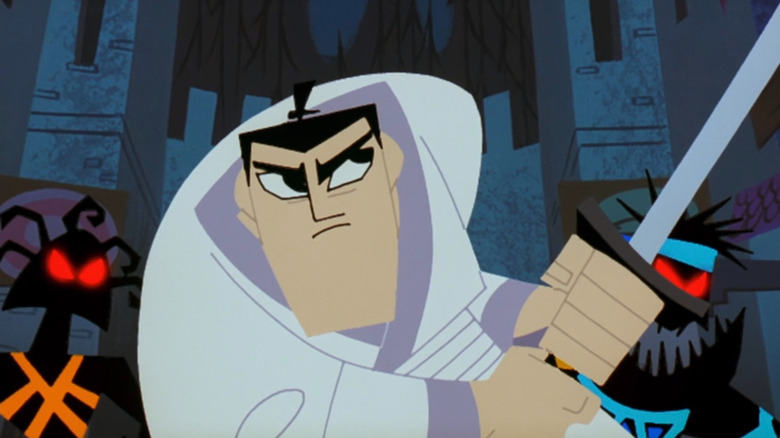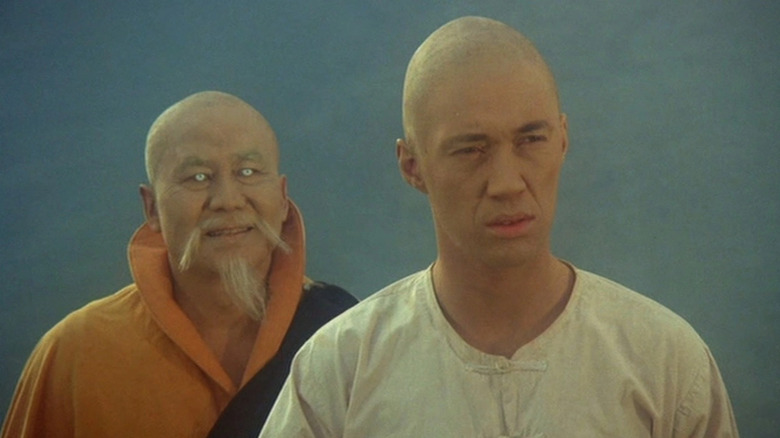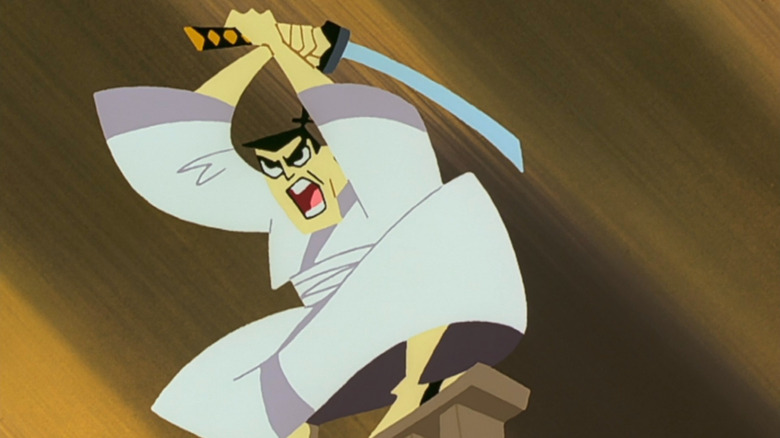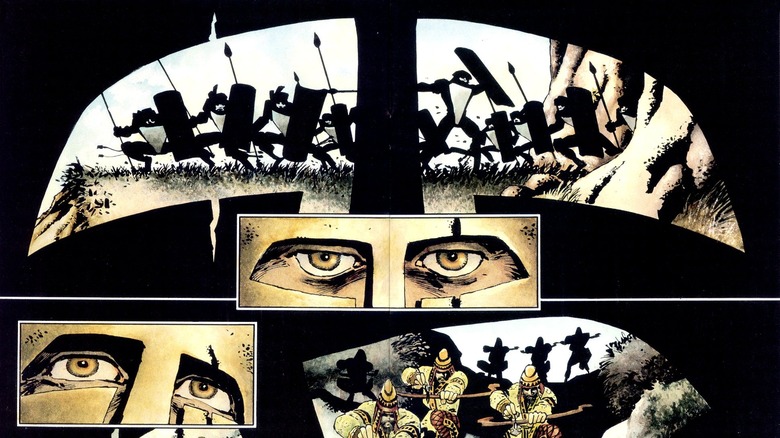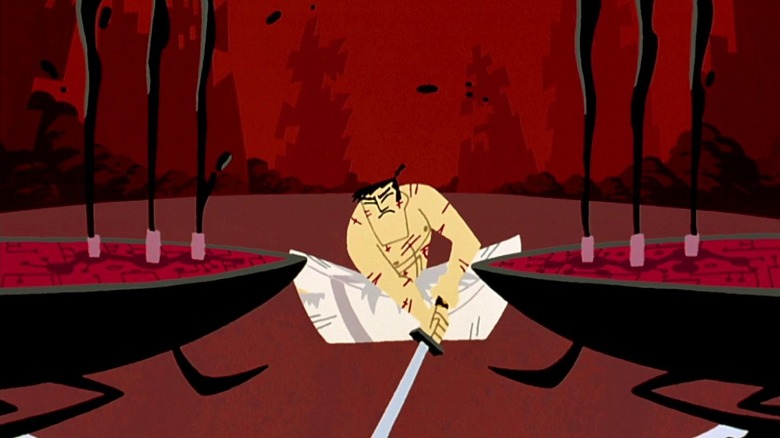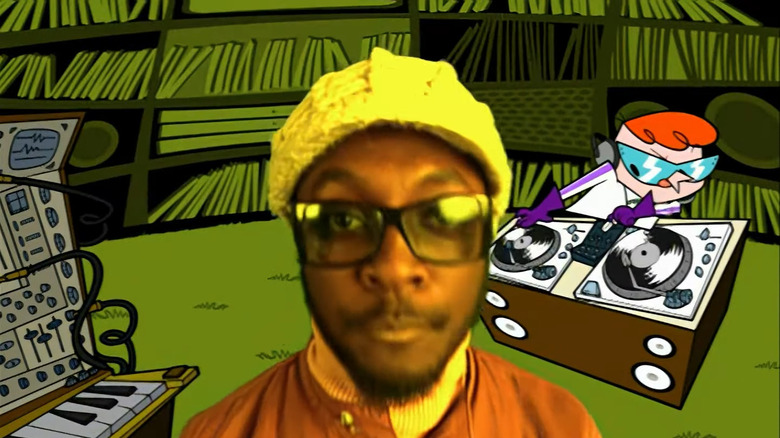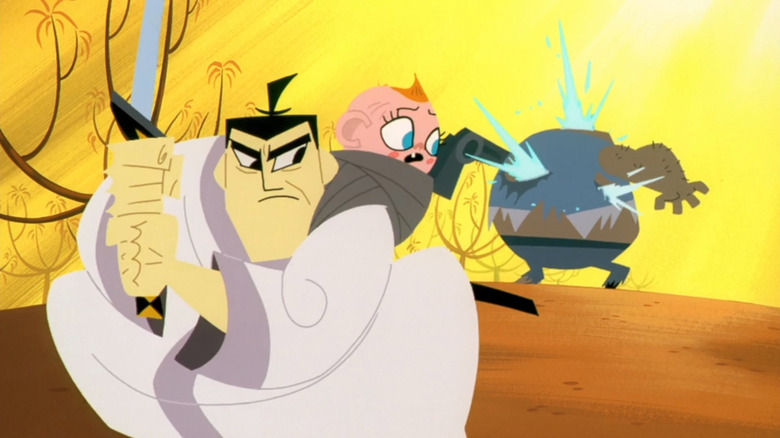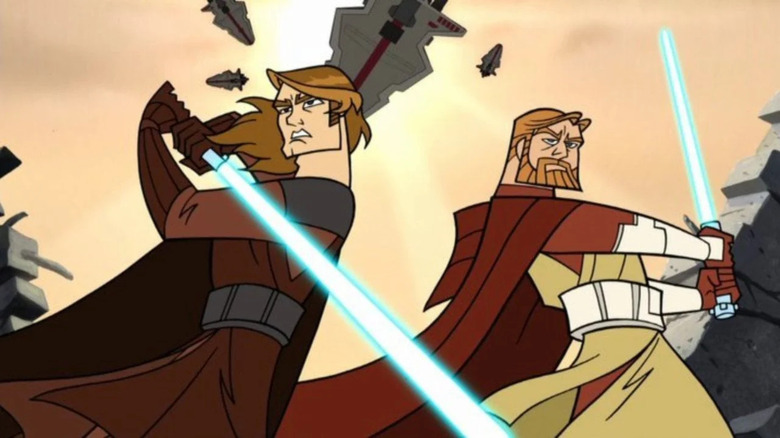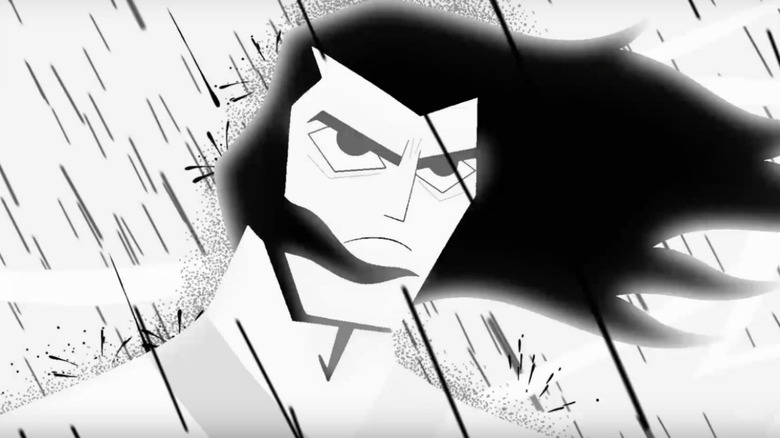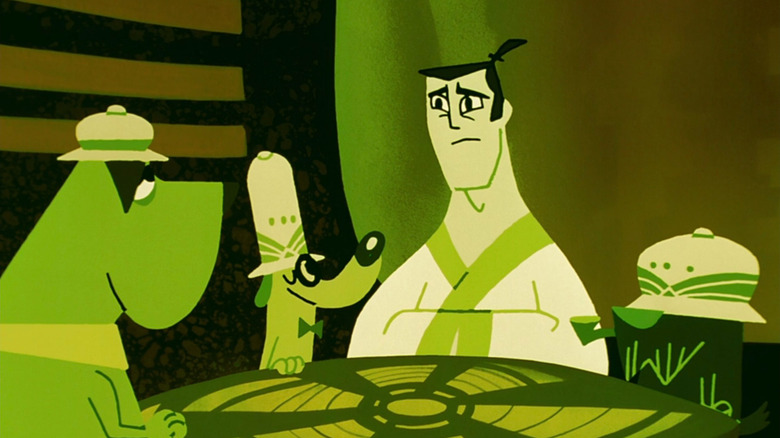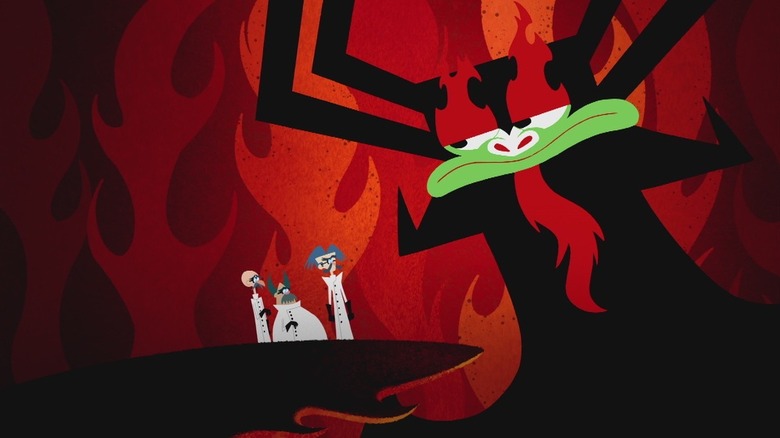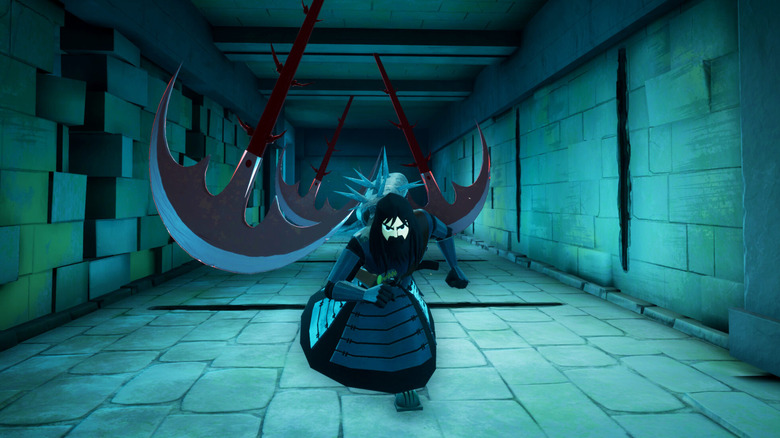11 Samurai Jack Facts Only The Most Battle-Hardened Samurai Might Know
In the 2000s, Cartoon Network produced a series of animated shows that are still fondly remembered to this day. Much of this success came from just allowing creators to run wild with their own original ideas for cartoons. Among this crop was Genndy Tartakovsky, the man behind "Dexter's Laboratory." Following that show's success, Tartakovsky was given the opportunity to helm another series, which eventually became "Samurai Jack."
From the moment it dropped back in 2001, it quickly became clear that "Samurai Jack" was an entirely different beast in both design and pacing. The series follows the titular samurai, who is tasked with dispatching Aku, the shape-shifting master of darkness. Before Jack can finish the job, Aku opens a portal in time and flings him into the future. Stuck as a sword-wielding fish out of water, Jack must seek out a time portal home while also undoing Aku's evil actions.
The story behind this beloved show is just as interesting as the series itself. So, grab your sword and order an extra thick pizza, because these are some "Samurai Jack" facts only the most battle-hardened samurai know.
It was inspired by the series Kung Fu
When you watch "Samurai Jack" (or just about any of Genndy Tartakovsky's animated works), it's clear that it takes influence from many things. Throughout the series, there are countless references to various movies, video games, classic novels, and television shows, which only adds to its stylistic diversity. On the subject of television, Tartakovsky has named a few choice influences, most notably "Kung Fu."
After being given the opportunity to make a new series by Cartoon Network, Tartakovsky colluded with Mike Lazzo, who would go on to work on the likes of "Robot Chicken" and "Rick & Morty" in the years that followed. Lazzo recalled his initial conversation with Tartakovsky during an interview with Entertainment Weekly. ”[Tartakovsky] said, 'Hey, remember David Carradine in 'Kung Fu?' And I was like, 'Yeah, that's really cool.' That was literally the pitch."
For those not in the know, "Kung Fu" is a 1972 action-adventure martial arts Western series featuring David Carradine (Bill from Quentin Tarantino's "Kill Bill" films) in the lead role of Kwai Chang Caine. Orphaned as a child, Caine wound up training at a Shaolin monastery, becoming skilled in hand-to-hand combat. In the show, Caine travels across the American Old West in search of his family's history, attempting to reunite with his lost half-brother Daniel. "Kung Fu" looks at the physical side of combat as well as the spiritual side, something you can most definitely see in "Samurai Jack."
It was born from Tartakovsky's desire for better action in cartoons
Cartoon Network was once a true maverick in terms of its programming diversity, offering creator-driven shows with less conventional setups. In terms of style, humor, and tone, the '00s were a time of great experimentation for the network, with many creators leaving sizable marks along the way.
Genndy Tartakovsky had already made an impact with his first original series "Dexter's Laboratory." The series, heavily reliant on its offbeat comedy, was the first taste of what Tartakovsky could do when handed full creative control — not just with plotting, but in terms of visuals, too. Much like his subsequent show, "Dexter's Laboratory" was a prime example of Tartakovsky's now-signature angular design style.
His desire to pursue "Samurai Jack" came from being burned out on comedy cartoons, he has revealed. He was also disenchanted with the state of action cartoons at the time, apparently sensing that the genre had untapped potential. "I'd always complained about action cartoons, so I thought I'd better walk the walk," he told Entertainment Weekly. "I thought, 'What do I want to see?' And samurais are one of my favorite things.”
Comic books and manga were big inspirations
If you watch any interview conducted with Genndy Tartakovsky, it's very clear that the man takes influence from many different things. Aside from film and television, Tartakovsky has also taken a few cues from the printed world of comic books and Japanese manga titles. In fact, during an interview featured on the "Samurai Jack" Season 4 DVD release, Tartakovsky revealed some key inspirations from those mediums.
He noted a particular fondness for the work of the legendary Frank Miller. If you look at "Ronin" and "300," it's clear where Tartakovsky took influence from, as they have a blockier and more angular design style. Additionally, it's clear that Tartakovsky took inspiration from Miller's style of formatting action scenes, often stylishly-violent affairs that take up whole pages of the book. Just take a look at any large scale battle scene in "Samurai Jack" and you'll definitely detect notes of "300."
In addition to American comics, Tartakovsky also took influence from Japanese manga, specifically the series "Lone Wolf and Cub." Penned by Kazuo Koike and illustrated by Goseki Kojima, the manga follows Ogami Itto, a former executioner for the shogun who goes on the run with his infant child after being double crossed. "Once I started reading that, I really started to get into it and feel even more of a mythos coming out," Tartakovsky said. "It was a lot of warrior spirit stuff and honor code, and I really loved that stuff."
The original series was never intended just for kids
"Samurai Jack" isn't like other animated shows for kids. In fact, it isn't even like other shows made for adults. One need only watch an episode to understand just how seriously the show takes itself, and, by proxy, its audience. From its writing to its animation style, nothing about "Samurai Jack" feels neutered or censored for Cartoon Network viewers. While the show never ventured into bloody violence, death was a real possibility in Jack's world. Not only that, but if you were a robotic monster of some kind, you'd better believe you were about to meet the business end of Jack's sword.
It's been a long maintained "cheat code" within animation that, as long as your character is a robot, you can basically mutilate them to your heart's content. So if Jack had to brutally dispatch a fleet of Aku's machines, he could do so, and the animators wouldn't have to hold back. Additionally, there are several episodes with intense horror elements, such as ghosts and even mind control, all masterfully woven into the show's ongoing narrative. If you caught "Samurai Jack" during your youth, then there's a solid chance there's at least one shocking scene that's stuck with you all these years.
The show's theme song was made by will.i.am
You can't talk about the impact of "Samurai Jack" without bringing up its absolute ear worm of a theme song. To this day, the words "Gotta get back, back to the past, Samurai Jack" live rent free in the brains of countless millennials. What only hardcore "Samurai Jack" fans might know is whose voice is behind the theme song. That would be none other than "Black Eyed Peas" founder William James Adams Jr., better known as will.i.am. Interestingly enough, this wasn't the only time that will.i.am lent his voice to a Cartoon Network property.
It wasn't uncommon during this time for the network to air bumpers before and after their commercial breaks. This included animated and live action vignettes, as well as short stylized music videos branded as "Cartoon Network Groovies." One such "Groovy" was the "Dexter's Laboratory" themed song titled "Secrets," featuring will.i.am in an onscreen capacity as well. The song, while definitely a cheesy bit of '00s nostalgia, is just as catchy as the "Samurai Jack" theme and another great example of will.i.am's talents.
The real reason the original ending was very abrupt
For the longest time, if you were to discuss "Samurai Jack" with anyone, there would always be the awkward topic of its ending — or lack thereof. Despite the series essentially having a predetermined end (Jack returning to his own time), we never got to that point. The original series ended up bowing out after four stellar seasons and a total of 52 episodes. However, the series finale didn't see Jack get home or defeat Aku, but instead protect a baby, much like the protagonist in the manga "Lone Wolf and Cub." It's definitely not a horrendous episode, but it's a far cry from what fans of "Samurai Jack" wanted in terms of a satisfactory ending.
During an interview with Red Carpet Report, Genndy Tartakovsky spoke about the open-ended conclusion of the series. He noted that, at the time of production, Cartoon Network was in a period of great transition in terms of its programming. This meant that when his crew asked him if they would get to finish the series properly, he couldn't give them a straight answer. The series ended up wrapping up on an abrupt note, which is where fans would be left hanging for 13 years.
It overlapped with Star Wars: Clone Wars
If you'd made a show as laborious and as complex as "Samurai Jack," surely you'd want to take a break afterward, right? Not if you're Genndy Tartakovsky, who jumped headfirst into another animated project. Tartakovsky and art director Scott Wills both worked on 2003's "Star Wars: Clone Wars" together, as the latter discussed during an interview with Red Carpet Report. "We didn't have time to think about [the ending of "Samurai Jack"], because we went right into 'Clone Wars.' They even overlapped, I think. There was no time to even think about it."
"Clone Wars" filled in the gap between the films "Attack of the Clones" and "Revenge of the Sith." The series, consisting of three to five-minute episodes (which increased to 12-15 minutes for the third season), showed off more of Anakin Skywalker and Obi-Wan Kenobi's exploits during the titular wars. In terms of animation, Tartakovsky's clean, angular style fit the "Star Wars" universe like a glove, leading to some supremely stylish animated action. It's nearly impossible to watch any of the lightsaber fights or Jedi-versus-droid battles on display without thinking of "Samurai Jack."
The show was such a success that it gave birth to the CGI "Star Wars: The Clone Wars" series that fans know and love today.
There was nearly a live-action Samurai Jack film
For as many film and television projects that see the light of day, there are at least twice as many that don't. Be it because of creative issues or studio meddling, some projects are simply doomed to remain in production hell, where films rarely escape from. One such cinematic project was a tentatively planned "Samurai Jack" film originally intended for a theatrical release in the 00s. This version was set to be in live-action and was going to be directed by Brett Ratner, the man behind the "Rush Hour" film series. Obviously the version never materialized, much to the relief of series creator Genndy Tartakovsky. "It kind of got lost in Hollywood a little bit," he told MTV. "I have a very strong idea for 'Jack,' and I want to stay faithful to it. In Hollywood, the first thing people want to do is change things, and so the best thing happened to it — it died."
In 2007, it was announced that the newly formed Frederator Films was to produce a 2D theatrical "Samurai Jack" film. Despite plans for a $20 million budget, this too never materialized, leaving Sony Pictures to throw its hat into the ring. This also went nowhere, and the idea of a "Samurai Jack" film — live-action or otherwise — slowly fizzled out. While a cinematic adaptation never came about, interest in the series never wavered, leading to the Adult Swim reboot in the late-2010s. This was the best outcome, according to Tartakovsky. However, there will always be a lingering feeling of "What if?" among "Samurai Jack" fans regarding this oft-discussed cinematic translation.
How the fans helped bring it back
When it comes to the world of television and movies, fans have learned that you should never say never, even in a day and age when it seems more and more animated shows are being launched into the sun before they have a chance to reach a proper conclusion. However, if "Samurai Jack" has proven anything, it's that sometimes it pays off for fans to be a little bit patient. Following the abrupt conclusion of the original series, fans kept the porch light on for Jack for over a decade. Despite widespread interest, for years it seemed that a proper conclusion to "Samurai Jack" would elude passionate fans.
However, that all changed when Adult Swim opted to team up with Genndy Tartakovsky, finally bringing the show back for a fifth and final season. The new season finally dropped in 2017, to much acclaim from fans and critics. The fifth season picks up 50 years after the Season 4 finale, with Jack still stuck in the future. Due to airing on Adult Swim, it was allowed to be far more mature with an added splash of legitimate violence. In a time when many shows don't get to reach their planned conclusions, let's be thankful that "Samurai Jack" did. It's better late than never, after all.
Aku's voice actor had to be changed
You can't talk about "Samurai Jack" without talking about its main antagonist Aku, the shape-shifting master of darkness. Aku has the distinction of being simultaneously one of the most intimidating yet hilarious animated villains ever made. He has an angular, shadow-like design complete with sharp fangs and fiery eyebrows. Additionally, his memorable design is matched in quality by his voice, which was originally provided by Makoto Iwamatsu, aka Mako.
Mako is perhaps best known for voicing Akiro the Wizard in "Conan the Barbarian" as well as Uncle Iroh in "Avatar: The Last Airbender." Whether it was live-action or animated, Mako always gave 100% to whatever role he was in, adding a sizable amount of humor and heart. Due to his passing in 2006 at the age of 72, any key roles he was attached to needed to be recast, including Iroh and Aku. Enter Greg Baldwin, a skilled voice actor in his own right, who was able to closely capture Mako's signature voice. Stepping into the shoes of an acting legend is quite the daunting task, but it's one that Baldwin met with ample gusto.
Jack has appeared in many video games
Much like many other Cartoon Network properties, "Samurai Jack" has had its fair share of video game tie-ins. In fact, the show's popularity has survived for so long that it's seen games released on the Nintendo GameCube, the Game Boy Advance, and even the Switch, crossing several generations of video game consoles. And Jack has appeared outside of Nintendo consoles, too.
Released in 2003 and 2004 respectively, "Samurai Jack: The Amulet of Time" landed on the Game Boy Advance and "Samurai Jack: The Shadow of Aku" was slotted onto the GameCube and PlayStation 2. During the series' hiatus, Jack made a few appearances in other Cartoon Network games, starting with its short-lived MMORPG "FusionFall." Additionally, Jack was a playable character for the brawler game "Cartoon Network: Punch Time Explosion," released on Nintendo 3DS, Wii, PlayStation 3, and Xbox 360.
Last but not least, there was "Samurai Jack: Battle Through Time," released in 2020 for Microsoft Windows, PlayStation 4, Xbox One, Nintendo Switch, and Apple Arcade. The game itself works as an alternative-ending for the series, even picking up during the finale of the fifth season. If you're a fan of the franchise and you're missing the series, there are plenty of games you can pick up to get back into Jack's world.
